Steps to view startup and shutdown history in Windows 10
Sometimes in the process of using a computer, you will need information such as system startup and shutdown history. For example, if you are a system administrator, the shutdown history data can play a useful role in troubleshooting procedures. Or sometimes you also want to know the history of turning on and off the system to see if your computer has been accessed illegally.
In this article, we will learn two ways to track Windows 10 PC startup and shutdown times correctly.
Use Event Viewer to extract startup and shutdown times
Windows Event Viewer is a great tool to help save all the activities that are happening on the computer. For each event that occurs on the system, the Event Viewer records an entry. Event Viewer is handled by the eventlog service, which cannot be stopped or turned off manually, as it is a core Windows service. In addition, Event Viewer will also log the startup and shutdown history of the eventlog service. Therefore, you can leverage this data to know when your computer is on or off.
Eventlog service events are logged with 2 event codes (Event IDs). ID 6005 indicates that the eventlog service has been started, while ID 6009 indicates that the eventlog service has been stopped. Take a look at the entire process of extracting this information from the Event Viewer.
Step 1. Open Event Viewer (by pressing Win + R and entering keywords eventvwr).

Step 2. Look in the left pane, open ' Windows Logs -> System '.

Step 3. In the middle pane, you'll see a list of events that happened while Windows was running. First, sort the event log with the corresponding ID by clicking the Event ID label. The data related to the Event ID column will be reordered.
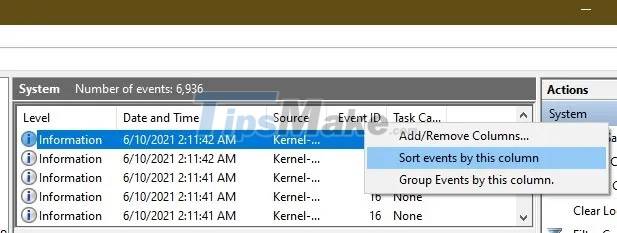
Step 4. If your event log is too large, sorting will not be available. You can now create a filter
task pane on the right side. Just click ' Filter current log '.
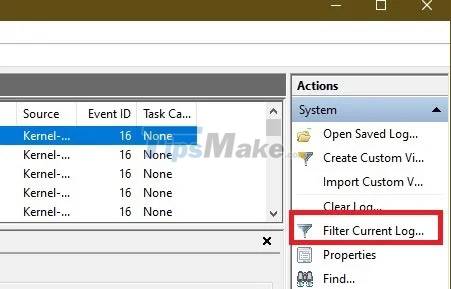
Step 5. Enter 6005 , 6006 in the Event ID field labeled < All Event IDs >. You can also specify the time period in the Logged section .
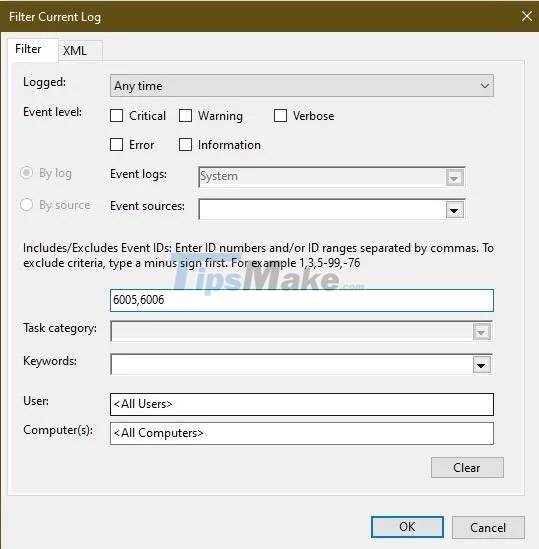
- Event ID 6005 will be labeled as 'The event log service was started'. This means that a system boot session has been performed.
- Event ID 6006 will be labeled as 'The event log service was stopped', corresponding to a system shutdown.
If you want to dig deeper, you can check out Event ID 6013, which shows the computer's uptime, and Event ID 6009 which shows processor information detected during boot time. Event ID 6008 will tell you that the system has started up after not being shut down properly.
Using the TurnedOnTimesView widget
TurnedOnTimesView is a simple tool that you can use to check startup and shutdown history. This utility can be used to view the list of shutdown and startup times of local computers or any remote computer connected to the network.
To use it, you will just need to extract and execute the TurnedOnTimesView.exe file. The application will immediately list you the startup time, the shutdown time, the active time between each shutdown and the shutdown, as well as the reason for the shutdown.
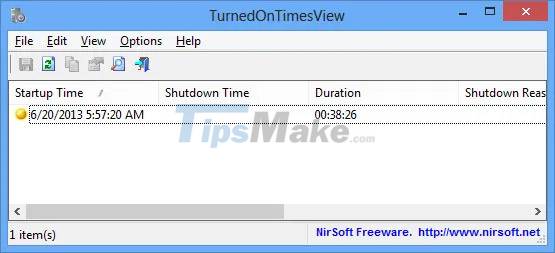
To see the startup and shutdown times of a remote computer, navigate to 'Options -> Advanced Options' and select 'Data source as Remote Computer'. Specify the computer's IP address or name in the Computer Name field, then click OK. Immediately, there will be a list showing detailed information of the corresponding computer, including data on the time on and off as mentioned above.
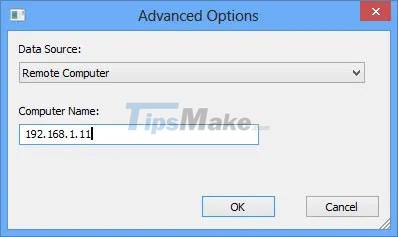
While you can always use Event Viewer for detailed breakdown of startup and shutdown times, TurnedOnTimesView has the advantage of a very simple and exceptionally easy-to-use interface. Which method to use depends on your preference.
You should read it
- Steps to use Event Viewer in Windows 10
- How to troubleshoot Windows with Event Viewer log
- Look up the Event ID from Event Viewer with the free tool
- 3 ways to delete all event logs in Windows 10
- How to create an Event Viewer shortcut on a Windows 10 desktop
- Manage the Event Log with the command line
- How to start / stop Windows Event Log
- Guide to watching live events on September 9 on different operating systems
May be interested
- How to Make a Shutdown Shortcut in Windows
 creating a shutdown shortcut in windows will allow you to shutdown your computer in a single click. this can be especially useful if you use windows 8, which has hidden the shutdown command behind several menus. windows 10 and windows 8...
creating a shutdown shortcut in windows will allow you to shutdown your computer in a single click. this can be especially useful if you use windows 8, which has hidden the shutdown command behind several menus. windows 10 and windows 8... - Create Shortcuts, Restart Your Computer ... on the Desktop Windows 10
 the easiest and fastest way to turn off windows 10 computer, reboot your computer, switch to hibernate mode, sleep mode ... is to use cortana virtual assistant or create a shortcut on the desktop screen.
the easiest and fastest way to turn off windows 10 computer, reboot your computer, switch to hibernate mode, sleep mode ... is to use cortana virtual assistant or create a shortcut on the desktop screen. - Shutdown command - Schedule the shutdown of Windows 10 with the Shutdown command
 shutdown command - schedule the shutdown of windows 10 with the shutdown command. you are downloading or automatically processing something on your computer but you do not wait until it is finished to turn off the computer. so you want to find a way to shut down your computer using shutdow
shutdown command - schedule the shutdown of windows 10 with the shutdown command. you are downloading or automatically processing something on your computer but you do not wait until it is finished to turn off the computer. so you want to find a way to shut down your computer using shutdow - How to View Browser History on Mac
 today's tipsmake will show you how to view your web browsing history on mac using safari, chrome or firefox browsers.
today's tipsmake will show you how to view your web browsing history on mac using safari, chrome or firefox browsers. - Instructions to view Instagram account history
 the instagram account history interface provides you with all of our information with different information items, from which users can know the time of creating an instagram account, the number of times to change the name of the instagram account.
the instagram account history interface provides you with all of our information with different information items, from which users can know the time of creating an instagram account, the number of times to change the name of the instagram account. - How to view command history from previous PowerShell sessions in Windows 10
 in this tutorial, tipsmake will show you how to view the entire command history from all previous sessions in windows 10.
in this tutorial, tipsmake will show you how to view the entire command history from all previous sessions in windows 10. - Trick to turn off the computer from the right-click menu on Windows 8
 on windows 8, to turn off the computer, you have to go through many steps. with this method, you can add shutdown to the right-click menu to turn off the computer faster despite being in any screen.
on windows 8, to turn off the computer, you have to go through many steps. with this method, you can add shutdown to the right-click menu to turn off the computer faster despite being in any screen. - Fix Windows startup errors with Startup Repair
 when you have trouble booting windows, try the startup repair tool included with windows 7 or windows vista.
when you have trouble booting windows, try the startup repair tool included with windows 7 or windows vista. - How to delete the old File History version in Windows 10
 if you use the built-in file history feature in windows 10 to back up data, over time it will take up a lot of your space. this article will show you how to view and delete the old version of file history.
if you use the built-in file history feature in windows 10 to back up data, over time it will take up a lot of your space. this article will show you how to view and delete the old version of file history. - Instructions for creating Slide to Shut Down shortcut on Windows 10 computer
 slide to shutdown is a feature that is integrated from windows 8, 8.1 and windows 10. this is a feature that helps you turn off quickly, shorten a lot of time to perform computer shutdown just by sliding the screen down. in the article below, network administrator will guide you how to create a slide to shut down shortcut on a windows 10 computer
slide to shutdown is a feature that is integrated from windows 8, 8.1 and windows 10. this is a feature that helps you turn off quickly, shorten a lot of time to perform computer shutdown just by sliding the screen down. in the article below, network administrator will guide you how to create a slide to shut down shortcut on a windows 10 computer










 Steps to fix corrupted Registry in Windows 10
Steps to fix corrupted Registry in Windows 10 Steps to use Event Viewer in Windows 10
Steps to use Event Viewer in Windows 10 How to extract VMDK virtual disk file on Windows
How to extract VMDK virtual disk file on Windows How to check screen resolution in Windows 10
How to check screen resolution in Windows 10 Steps to set up VPN on Windows 10
Steps to set up VPN on Windows 10 Steps to remove installed apps from Store on Windows 10
Steps to remove installed apps from Store on Windows 10